Need to create a lesson on classical music for kids? There are several pieces of classical music every kid should know, and I would put all five of these songs on that list. Let me share how I present these songs in my classroom to help students learn and have fun with classical music.
Want to jump right into classical music for your students? Here is an amazing resource to get you started.
Is Classical Music For Kids?
Yes! You just have to know how to deliver it. I have had my kids begging to do the William Tell Overture again. Or laughing their hearts out to the Can Can by Offenbach. I’ve even gotten them jamming out to Mozart’s Eine Kleine Nachtmusik! Any song can be made accessible to kids with just a little imagination.
What Are Some Pieces of Classical Music Every Kid Should Know?
There are SO many great pieces of classical music, it is hard to narrow down which songs are essentials. It will depend on what you hope to accomplish with them. So I will simply tell you which classical pieces I have found to be essential in my own classroom, and what concepts I use them to teach.
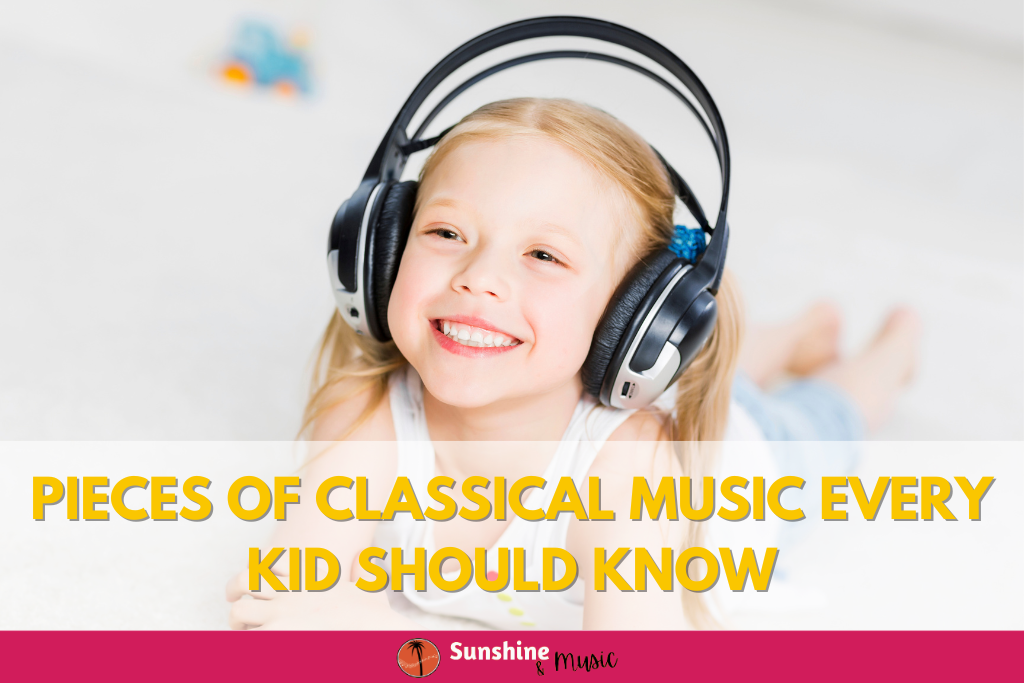
- William Tell Overture by Rossini – dynamics (multiple grade levels)
- Variations on Simple Gifts by Copland – theme and variation (4th grade)
- Hoedown from Rodeo by Copland – rhythm reading/dynamics (3rd/4th/5th)
- The Rider by Kabalevsky – ABA form (K/1/2)
- Liberty Bell March by Sousa – musical form/dynamics/steady beat (1st)
- Stars and Stripes Forever by Sousa – steady beat (K)
- Carnival of the Animals by Saint-Saens – variety of musical elements (K/1)
- Danse Macabre by Saint-Saens – instrument timbres/legato and staccato (5th)
- Spring from the Four Seasons by Vivaldi – musical form/dynamics/string timbre (3rd)
- Fanfare for the Common Man by Copland – largo tempo/brass timbre (3rd/4th)
- Trepak from The Nutcracker by Tchaikovsky – musical form (1st/2nd)
- Can Can from Orpheus in the Underworld by Offenbach – form/dynamics/rhythm reading (2nd/3rd)
- In the Hall of the Mountain King – dynamics/tempo (2nd)
Are these songs that are part of your yearly repertoire – or that you would like to add? What if I told you I have a bundle that has listening maps to all these songs (plus lots more!).
Click here to check out my Growing Listening Map Bundle!
How Can I Make Classical Music Fun For Kids?
You might be looking at that list and thinking – that’s all well and good, but how do I use all these great songs in my classroom? I’m so glad you asked! I don’t have time to tell you what I do for ALL the songs on that list today (my hands hurt just thinking about the length of that blog post!). But I am going to take some of the songs on this list today and let you know how I use them in my own classroom with my students.
William Tell Overture
The William Tell Overture by Giachino Rossini is top of my list of classical music for kids. Students usually recognize this piece from somewhere, and they love the excitement it conveys. We use this piece to learn about forte and piano in my classroom.
Artie Almeida has several fun activities for the William Tell Overture. One of my favorites is a routine with little stick horses. However, that does require making or buying a classroom set of stick horses (you may have to make trips to multiple Dollar Trees to make that happen!). Another equally fun option is her parachute activity from Parachutes and Ribbons and Scarves, Oh My!. Kids take an audible gasp every time I take the parachute out. Something FUN is about to happen.
I have also created my own little activity to emphasize forte and piano. I take two different colored cards – made from construction paper. One signifies FORTE and the other signifies PIANO. We move the cards around to match the dynamics of the music. I’ve created all sorts of motions to go with the different parts and the kids eat it up. The more you ham it up, the better!
Fanfare for the Common Man
Fanfare for the Common Man is one of my personal favorite pieces. And yet it wasn’t until this last year that I brought it into my classroom. I tend to gravitate towards the fast paced songs when choosing classical music for kids, but I realized, they need to exposure to slow tempo music as well. And it can be just as fun.
I created a scarf routine to Fanfare for the Common Man that actually went over pretty well with my upper elementary students. Click here for the basic breakdown of the movements.
Hoedown from Rodeo
Hoedown from Rodeo is another great piece of classical music for kids. This song just begs for a rhythm play along. I start off having students listen along with a listening map so they can identify the main sections more clearly.
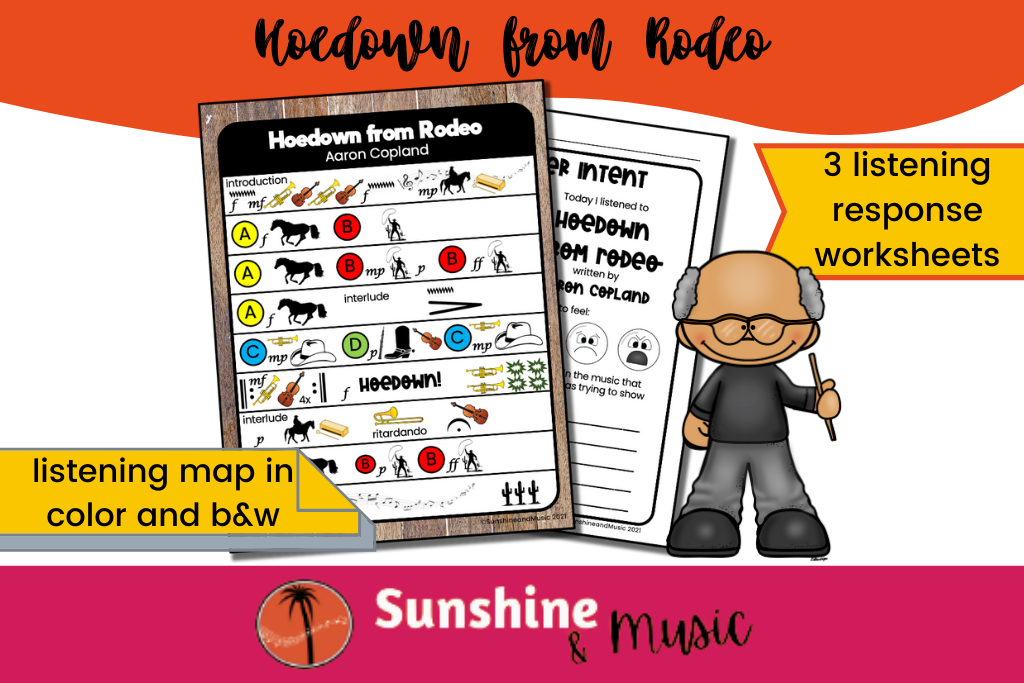
Then I add in some rhythms. Here are the rhythms I do with each section of the piece.
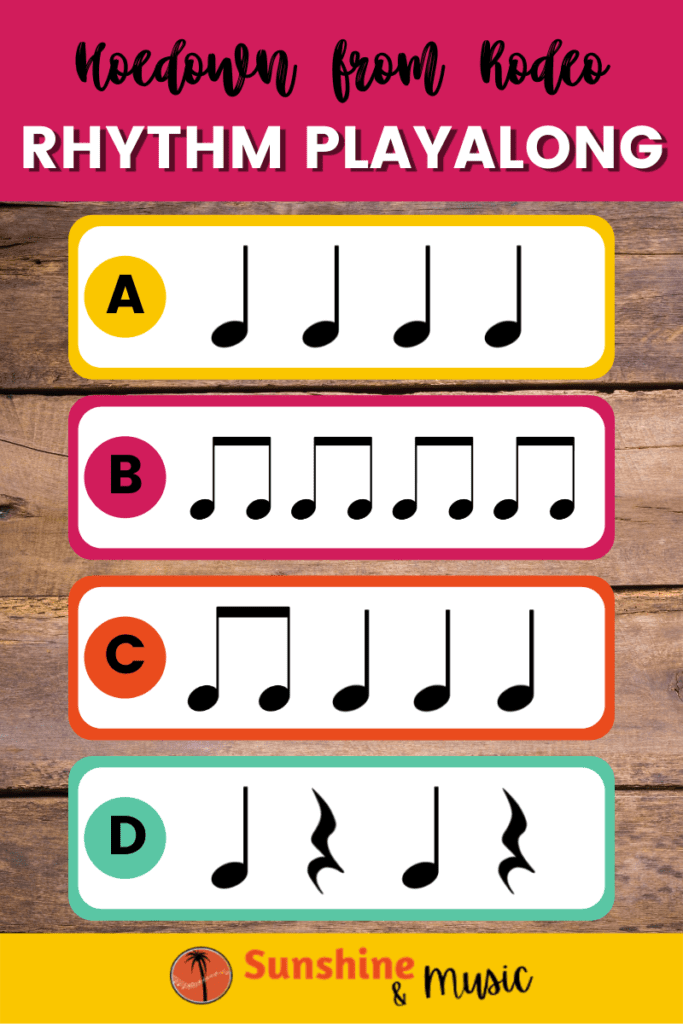
This piece also lends itself easily to movement – whether it’s a sqaure dance or adding a parachute activity. Anyway you present it, you students are sure to love this classical piece.
Spring from The Four Seasons
I like to use Spring from the Four Seasons by Vivaldi to exhibit the string family when we are learning about the instruments of the orchestra. After listening to it, we learn a quick scarf activity, moving with the different sections.
Students are divided into groups and get to do interpretive movement during the solo violin sections, moving like a rainstorm, or a river, or birds during different sections. Then we all move together during the main sections.
Liberty Bell March
This classic by John Phillip Sousa is a great one to share with your younger students. I add some movement during the different sections, and then of course, we add in our version of the Liberty Bell. Usually this part gets played by the triangle in my room.
Students love any time they get to play instruments along with a song. I have used triangles every year, but use what works best for your classroom – finger cymbals, tambourines, maybe even boomwhackers!
You could even turn it into a passing game and after you play the instrument, pass it along to the next person in the circle and then they play the next bell sound.
Where Can I Get More Classical Music For Kids?
What if I told you all the songs I just mentioned are part of the Classroom Classics 2 Listening Map Set.
If you want to share more classical music with your students, I have the ultimate resource. My Growing Listening Map Bundle contains over 40 listening maps and it continues to grow each year! Check out this video to learn all about it, and click here to lock in listening maps for life!
Want to Learn More About How to Use Listening Maps in Your Classroom?
Check out my blog post – Listening Maps for Music: The Ultimate How To Guide. It has everything you need to implement this useful resource in your classroom.

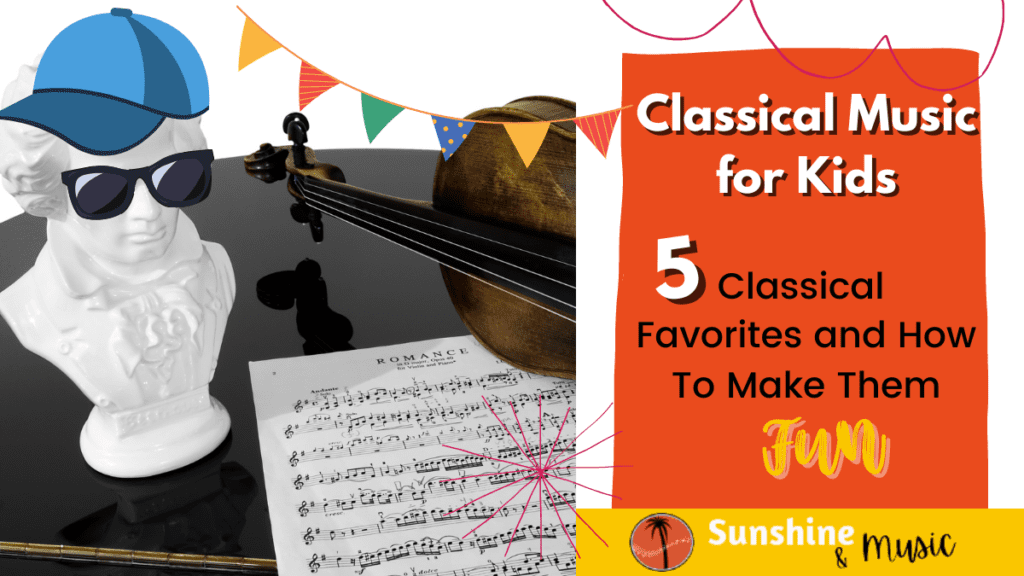





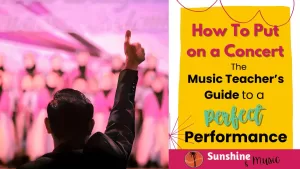
2 Responses